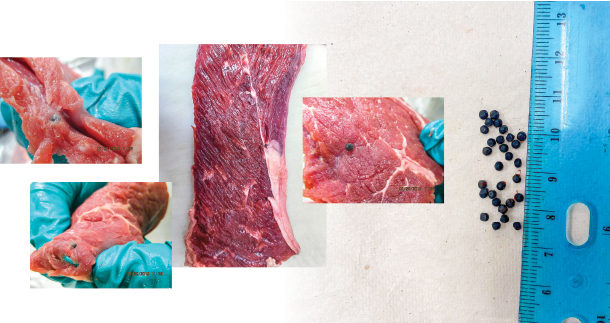In rare situations when the beef industry finds itself the subject of disparaging headlines, it is generally successful in combating misinformation with factual, positive messaging. But consider having to respond to a news story that reveals a diner has bitten into a shotgun pellet in a carry-out hamburger. Whether birdshot becomes embedded in beef carcasses directly from producers using shotguns on cattle or indirectly from hunters, consumers would find neither explanation justified.
Fortunately, thanks to a number of safeguards in place on the production line in packing plants and with further processors, it’s highly unlikely for a birdshot pellet to roll across someone’s dinner plate. But the potential is still there.
Jennifer Raspaldo, director of quality and materials for OSI Group LLC, a further processor known for grinding beef patties for McDonald’s, says that foreign object contamination is the company’s biggest battle from a food safety perspective.
“Foreign material is the number one disruption in our process because it is not supposed to be there, and we can’t send out finished product with it,” Raspaldo says. “There are some situations where we find foreign material that does not come from the packing plant but is known to come in with the live animal – the most frequent being birdshot.”
Birdshot is considered an adulterant by the USDA Food Safety Inspection Service (FSIS) and by the FDA. Products containing foreign contaminants cannot be sold for human consumption and, when found, entire animals can be condemned.
According to Catie Beauchamp, the former chair of the Beef Industry Food Safety Council (BIFSCo) who leads food science, quality and safety at ButcherBox, birdshot was a hot topic at the 2020 Beef Industry Safety Summit. As a result, safety summit attendees were surveyed on how foreign materials impact their company and product. Of the 67 survey responses, an average of 112 birdshot instances were reported annually per respondent across the packer, grinder, further processor and retail/distributor sectors.
Many further processors, like OSI Group, monitor for metal in the final phases of production, before finished products are packaged to ship. Metal detectors regularly serve this role, but X-ray technology is becoming more prevalent due to its heightened sensitivity to detecting foreign materials.
Raspaldo says that X-ray sensitivity helps her company identify foreign materials earlier in production, reducing the likelihood of birdshot incidents requiring finished products to be reworked. If birdshot is detected in formed patties, time and money is lost.
“The product is held, segregated and then at a later time … we have to take each patty and run it back on a belt through another X-ray or metal detector to make sure we caught all of the pieces that were part of the incident,” Raspaldo explains.
Birdshot in raw material presents enough concern for OSI Group to regularly record instances. When an instance is encountered, all affected product generated within a half-hour production window must be identified and reworked. This typically consists of approximately 6,500 pounds of product or 65,000 finished patties. OSI Group estimates the cost of rescreening the product to be about 9 cents per pound depending on market price.
Beef found to contain birdshot is considered inedible and can only be sent to specific renderers who will accept contaminated product. Even then, it loses 100% of its original value, as renderers will not pay for product that may contain foreign objects.
Despite time and money lost, Raspaldo says the reworking process is done with consumer safety in mind.
“It is especially important in these defined instances to make sure we have isolated all of the pieces,” she says. “That’s why we are doing the rescreening – to make sure we have done all we can to prevent an injury to someone consuming it.”
News of a beef product injuring a consumer is the last thing any cattle producer wants to hear, yet there are only a few ways birdshot can become imbedded in beef carcasses. Sometimes the situation is inadvertent, but there are circumstances where birdshot in cattle is simply the result of poor decision-making or misinformation.
Prevention
Preventing birdshot in the live animal can be as straightforward as not using shotguns to gather cattle, but packers and processors still take on the brunt of the responsibility for preventing birdshot from entering the food supply.
So whose job is it to keep foreign objects that originate at the ranch off of consumers’ plates? According to the Beef Quality Assurance (BQA) program, cattle producers are obligated to take on this burden.
Ron Gill, associate department head for Texas A&M University AgriLife Extension, says that preventing birdshot in carcasses is simple. Cattle should never be shot under any circumstances. Even if a projectile is “required” for things like getting cattle out of thick brush or stopping bulls from fighting, Gill says a shotgun is not a cattle-handling tool. Instead, use an option that will not penetrate the hide.
“Most people don’t think birdshot will penetrate the skin on cattle and use that as the excuse to keep doing what is easy for them,” Gill says. “We suggest using a slingshot if a projectile is required to move cattle.”
Other options include good management practices, like maintaining a controlled breeding season or using electric wire fencing to keep unwanted bulls out. Allowing bulls to establish dominance before the breeding season will help reduce fighting.
Although hunters typically do not cause problems that result in a high likelihood of embedded pellets, they tend to be another explanation for birdshot contamination. To help reduce inadvertent or even deliberate instances of hunters shooting cattle, educate them on the consequences of birdshot getting into the beef supply.
“Have a conversation with all hunters,” Gill suggests. “Let them know that if any cattle come back on the owner for birdshot, they will lose hunting privileges and forfeit or void any existing hunting leases.”
BQA guidelines also address managing unruly or uncontrollable animals. In rare situations where animals at the end of their productive lives are uncontrollable and cannot be contained or gathered by means other than with a shotgun, the guidelines recommend the animal be humanely euthanized on the premise and properly disposed of. The BQA program suggests removing cattle from hunting areas to avoid accidental shootings.
Many producers have been in a situation or know someone who views a shotgun as a solution rather than a problem. Despite the severity of birdshot contamination in carcasses, the topic of using shotguns as handling tools is often met with a chuckle. It is time to shift our thinking and take basic steps to prevent birdshot contamination at the source rather than relying solely on supply chain partners to keep “birdshot burgers” out of the news.
Editor note: Both birdshot and buckshot are a problem, but for the purposes of the article, only birdshot is mentioned.











